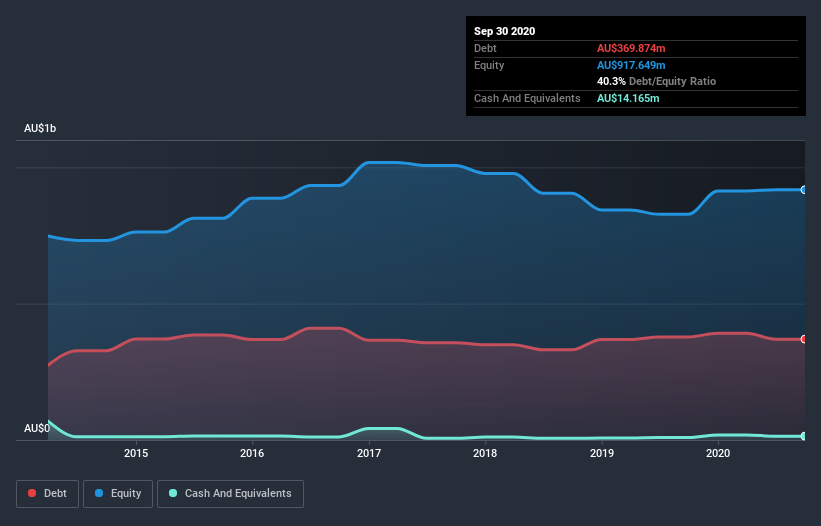Here's Why Australian Agricultural (ASX:AAC) Can Afford Some Debt

The external fund manager backed by Berkshire Hathaway's Charlie Munger, Li Lu, makes no bones about it when he says 'The biggest investment risk is not the volatility of prices, but whether you will suffer a permanent loss of capital.' It's only natural to consider a company's balance sheet when you examine how risky it is, since debt is often involved when a business collapses. Importantly, Australian Agricultural Company Limited (ASX:AAC) does carry debt. But should shareholders be worried about its use of debt?
When Is Debt A Problem?
Debt is a tool to help businesses grow, but if a business is incapable of paying off its lenders, then it exists at their mercy. Part and parcel of capitalism is the process of 'creative destruction' where failed businesses are mercilessly liquidated by their bankers. However, a more usual (but still expensive) situation is where a company must dilute shareholders at a cheap share price simply to get debt under control. By replacing dilution, though, debt can be an extremely good tool for businesses that need capital to invest in growth at high rates of return. When we examine debt levels, we first consider both cash and debt levels, together.
View our latest analysis for Australian Agricultural
How Much Debt Does Australian Agricultural Carry?
As you can see below, Australian Agricultural had AU$369.9m of debt, at September 2020, which is about the same as the year before. You can click the chart for greater detail. However, it does have AU$14.2m in cash offsetting this, leading to net debt of about AU$355.7m.

A Look At Australian Agricultural's Liabilities
The latest balance sheet data shows that Australian Agricultural had liabilities of AU$39.8m due within a year, and liabilities of AU$454.1m falling due after that. Offsetting these obligations, it had cash of AU$14.2m as well as receivables valued at AU$14.7m due within 12 months. So it has liabilities totalling AU$465.1m more than its cash and near-term receivables, combined.
This is a mountain of leverage relative to its market capitalization of AU$702.2m. Should its lenders demand that it shore up the balance sheet, shareholders would likely face severe dilution. When analysing debt levels, the balance sheet is the obvious place to start. But ultimately the future profitability of the business will decide if Australian Agricultural can strengthen its balance sheet over time. So if you're focused on the future you can check out this free report showing analyst profit forecasts.
Over 12 months, Australian Agricultural made a loss at the EBIT level, and saw its revenue drop to AU$295m, which is a fall of 9.9%. We would much prefer see growth.
Caveat Emptor
Over the last twelve months Australian Agricultural produced an earnings before interest and tax (EBIT) loss. Its EBIT loss was a whopping AU$166m. Considering that alongside the liabilities mentioned above does not give us much confidence that company should be using so much debt. Quite frankly we think the balance sheet is far from match-fit, although it could be improved with time. Surprisingly, we note that it actually reported positive free cash flow of AU$16m and a profit of AU$44m. So one might argue that there's still a chance it can get things on the right track. There's no doubt that we learn most about debt from the balance sheet. But ultimately, every company can contain risks that exist outside of the balance sheet. For instance, we've identified 3 warning signs for Australian Agricultural (2 make us uncomfortable) you should be aware of.
If, after all that, you're more interested in a fast growing company with a rock-solid balance sheet, then check out our list of net cash growth stocks without delay.
If you’re looking to trade Australian Agricultural, open an account with the lowest-cost* platform trusted by professionals, Interactive Brokers. Their clients from over 200 countries and territories trade stocks, options, futures, forex, bonds and funds worldwide from a single integrated account. Promoted
New: Manage All Your Stock Portfolios in One Place
We've created the ultimate portfolio companion for stock investors, and it's free.
• Connect an unlimited number of Portfolios and see your total in one currency
• Be alerted to new Warning Signs or Risks via email or mobile
• Track the Fair Value of your stocks
This article by Simply Wall St is general in nature. It does not constitute a recommendation to buy or sell any stock, and does not take account of your objectives, or your financial situation. We aim to bring you long-term focused analysis driven by fundamental data. Note that our analysis may not factor in the latest price-sensitive company announcements or qualitative material. Simply Wall St has no position in any stocks mentioned.
*Interactive Brokers Rated Lowest Cost Broker by StockBrokers.com Annual Online Review 2020
Have feedback on this article? Concerned about the content? Get in touch with us directly. Alternatively, email editorial-team (at) simplywallst.com.
About ASX:AAC
Mediocre balance sheet with questionable track record.
Similar Companies
Market Insights
Community Narratives




